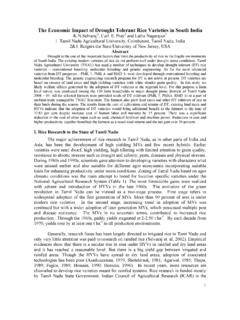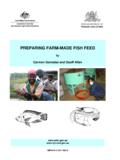Transcription of Planters and their Components - AgEcon Search
1 Planters and their Components Types, attributes, functional requirements, classification and description J R Murray, J N Tullberg and B B Basnet School of Agronomy and Horticulture, University of Queensland, Australia Australian Centre for International Agricultural Research Canberra 2006. The Australian Centre for International Agricultural Research (ACIAR) was established in June 1982 by an Act of the Australian Parliament. Its primary mandate is to help identify agricultural problems in developing countries and to commission collaborative research between Australian and developing country researchers in fields where Australia has special competence.
2 Where trade names are used this does not constitute endorsement of nor discrimination against any product by the Centre. ACIAR MONOGRAPH SERIES. This series contains the results of original research supported by ACIAR, or material deemed relevant to ACIAR's research and development objectives. The series is distributed internationally, with an emphasis on developing countries. Australian Centre for International Agricultural Research, 2006. Murray, J R, Tullberg, J N and Basnet, B B. 2006. Planters and their Components : types, attributes, functional requirements, classification and description. ACIAR Monograph No. 121. ISBN 1 86320 462 8 print 1 86320 463 6 online Edited by Anne Burgi, Substitution, Melbourne, Australia Cover design, Sam Highley, Clarus Design, Canberra, Australia Printing, Elect Printing, Canberra, Australia Planters AND their Components .
3 Table of Contents Section 1: 7. Section 2: Crop 8. Overview of crop 8. The agronomic requirements for crop 10. Agronomic requirements for germination .. 10. Agronomic requirements for emergence .. 15. Agronomic requirements for 19. planter functional requirements for crop establishment .. 24. planter classification and 25. Section 3: planter classification .. 26. Classification parameters .. 26. The number of rows planted .. 26. The method of attachment to, and the type of, power source .. 26. The type of planter .. 27. Examples of planter 29. A broadcast planter .. 29. A drill planter .. 29. A precision planter .. 30. A dibble planter .. 30. Section 4: planter component parts.
4 31. Section 5: planter soil-engaging Components .. 32. Group 1 Soil and residue cutting devices .. 34. Functional requirements of soil and residue cutting 34. Operational requirements of soil and residue cutting 35. The types of disc coulter soil and residue cutting devices .. 36. Group 2 Row preparation devices .. 40. Functional requirements of row preparation devices .. 40. Operational requirements of row preparation devices .. 41. The types of row preparation devices .. 42. Group 3 Furrow opening 51. Functional requirements of furrow 51. Operational requirements of furrow 51. Types of furrow opener .. 52. Group 4 Seed firming devices .. 81.
5 Functional requirements of seed firming 81. Operational requirements of seed firming devices .. 81. Types of seed firming devices .. 82. Group 5 Seed covering 84. Functional requirements of seed covering devices .. 84. Operational requirements of seed covering devices .. 84. Types of seed covering 85. Group 6 Row specific seedbed firming devices .. 93. Functional requirements of row specific seedbed firming devices .. 93. Operational requirements of row specific seedbed firming devices .. 94. Types of row specific seedbed firming 94. Group 7 Non row specific seedbed firming/levelling devices .. 102. Functional requirements of non row specific firming/levelling devices.
6 102. Operational requirements of non row specific firming/levelling devices .. 102. Types of non row specific seedbed firming/levelling devices .. 103. 3. Planters AND their Components . Section 6: planter furrow opener depth control Components .. 106. Functional requirements of furrow opener depth control 107. Operational requirements of furrow opener depth control 107. Types of furrow opener depth control mechanisms .. 108. Frame section gauging systems' for furrow opener depth control .. 108. Individual row gauging systems' for furrow opener depth 111. Section 7: planter seed metering Components .. 118. Functional requirements of seed metering 118.
7 Operational requirements of seed metering 118. Types of seed metering devices .. 119. Mass flow seed metering devices .. 120. Precision seed metering devices .. 127. Selection of seed meter type .. 141. Section 8: planter seed delivery 142. Functional requirements of seed delivery systems .. 142. Operational requirements of seed delivery systems .. 143. Types of seed delivery 144. Gravity drop seed delivery systems .. 144. Mechanically assisted seed delivery systems .. 145. Pneumatic seed distribution and/or delivery systems .. 147. Section 9: Examples of planter 153. Example 1 A broadcast 154. Example 2 A drill 155. Example 3 A precision planter .
8 156. Example 4 A dibble planter .. 157. Section 10: planter classification and description keys .. 158. A key for planter 158. Section 11: Conclusion .. 165. Section 12: Further information .. 166. Section 13: Bibliography .. 167. 171. 4. Planters AND their Components . Foreword Sustainable improvement in the livelihoods of poor farmers in developing countries depends largely on the adoption of improved, resource-conserving cropping systems. These systems will often be based on methods involving zero tillage bed planting, but adaptation is usually needed to suit local soils, crops and conditions. It is vitally important that this technology, already used in many parts of the world, be adapted easily to the low-resource situation.
9 A major constraint to adoption of improved resource-conserving cropping systems in developing countries is the lack of simple planting equipment. While most of the necessary Components already exist, information on the availability, attributes and performance of equipment is lacking and effective communication between scientists can be difficult. ACIAR is publishing this compendium to help address the problem. The authors combined the extensive planting equipment experience of Mr J R Murray from the School of Agriculture and Horticulture at the University of Queensland with the machinery systems knowledge of Dr J N Tullberg and the database skills of Dr B B Basnet.
10 An immediate obstacle to developing the manual was the absence of adequate, comprehensive and uniform terminology to describe both planting machines and their Components . For example, all machines used for crop establishment from seed are referred to here as Planters ', although in some parts of the English-speaking world they are usually referred to as seeders' or drills'. Machinery component terminology is even more complex, with many of the terms used meaning totally different things to different people, even within the same country. The inclusion of pictures helps solve this problem. This manual provides a valuable reference for research and extension personnel engaged in the selection, adaptation and/or construction of complete Planters appropriate to specific soil, crop, climate and residue conditions.















